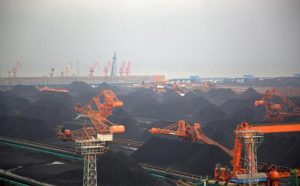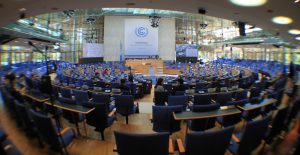It has become impossible to deny the urgency of China’s carbon emission challenge. Already the world’s largest energy consumer, China’s energy demand is predicted to double between 2007 and 2030, according to the IEA. As power generation continues to be 70% reliant on coal, this expansion is associated with an enormous increase in carbon emissions. China became the world’s largest emitter in 2006, and is expected to contribute three-quarters of the growth of global emissions until 2030.
China’s leadership has adopted a number of ambitious low-carbon goals in response to these trends. The most recent Five-Year-Plan (FYP) incorporated mandatory energy standards and emission targets, primarily for industrial units and the power generation sector, which have led to significant progress. However, the extent to which China’s low-carbon efforts may be successful is limited; fossil fuel systems are difficult to change because they are already embedded in society. This resistance is often referred to as “carbon lock-ins”, a concept that describes how high-carbon technologies, infrastructural systems and economic and social structures are interconnected and mutually reinforcing. Carbon lock-ins are created on three dimensions: physical systems, rules, and actor interests.
Carbon lock-ins
The first set of lock-ins consists of investments into high-carbon infrastructure. In China, such lock-ins are considerable – the largest consist of investments into coal plants. China’s 11th FYP included a strategy of improving the efficiency of the power sector through shut-downs and retrofits of small, inefficient plants. However, the continued need for coal power generation required investments into new plants that will be active decades into the future. The operation of these coal plants over a normal economic lifetime accounts for locked-in emissions of over 85 Gt until 2035. This is an amount larger than the total locked-in emissions of the US over the same period.
Similar lock-ins exist in the industrial sector. Industry accounts for about two-thirds of China’s energy use, out of which the majority is consumed by electric vehicles. As a large proportion of these vehicles operate below optimum energy standards, further adoption of efficiency measures may contribute to reduced emissions. However, such upgrading will likely only raise efficiency by a few percentage points. Due to the large and rapid investments into the industrial sector over the past decades, the IEA estimates that around 44 Gt of carbon emissions is locked into industrial equipment until 2035. This is equivalent to the estimated total size that global emissions are allowed to reach in 2020, for global temperatures not to rise above two degrees celsius.
Material carbon lock-ins also exist in the built environment. The share of energy consumed by buildings remains comparatively limited in China and locked-in emissions amount to only about 8 Gt until 2035. However, large investments into the construction sector contribute to a rapidly deteriorating carbon footprint. Out of China’s increase in emissions between 2002 and 2007, around 60% was created through capital investments, with investments into large construction projects acting as a key driver of emission growth. The expansion of the construction sector and its supply chain (e.g. steel and cement) thus fuels the growth of carbon-intense industrial activities. Many rapidly growing cities in China are also beginning to display tendencies towards urban sprawl, which may lock cities into unplanned urban shapes that are not optimal in terms of energy use.
The second form of carbon lock-in consists of rules that support and reinforce high-carbon systems. This includes regulative rules (legislation, market rules), cognitive rules (habits and routines), and normative rules (ideals and values).
In China, this includes existing contracts with high energy using units, such as contracts signed with large industrial enterprises and their legal agreements with suppliers and staff. It also includes market-based factors, such as subsidies for fossil fuels, although these are being gradually phased out. A crucial market barrier is made up of prohibitively high costs of adopting low-carbon technologies. Private actors in the industrial and construction sectors tend to opt for cost-efficient solutions that often exclude green development. For example, the cost of installing environmental protection equipment or industrial recycling technologies is often too high for small factories. Similarly, green construction and eco-city building are often seen as high-cost options rather than common building standards.
In relation to this issue, habits that create a barrier to low-carbon developments include the experience of planners, engineers and designers. Their lack of experience in the adoption of low-carbon technologies, for example ways to construct energy saving buildings, prevents the spread of low-carbon practises.
GDP growth is still king
Ideals and values contribute to carbon lock-ins in China through the over-arching priority attached to economic growth. These growth ideals are closely related to the last form of lock-ins, made up of actor interests. Research shows that vested interests of powerful actors, such as industrial units and energy enterprises, tend to act as a barrier to low-carbon development. In China, the influence of such organisations is thought to be considerable, but it remains opaque, due to the lack of transparency of policy-making processes. It has been suggested that the influence of national oil companies (NOCs) and local industry has been visible through their success in influencing prices of oil (to protect producers) and electricity (to protect end users), supporting continued production and consumption of fossil fuels.
Moreover, the development interests of key decision makers tend to be based on economic priorities that support high-carbon development. This is, firstly, because China’s performance evaluation system primarily rewards local leaders for creating economic growth. Although energy efficiency has been turned into a “hard” performance target, local leaders continue to prioritise growth over environmental performance. Secondly, as China’s financial system limits local government income, local leaders are incentivised to support activities that expand their tax-base and create off-budget income. These priorities lead to encouragement of rapid, revenue-creating activities, which tend to be high-carbon development options: industrial expansion, land development and construction.
Research on sociotechnical change suggests that over time, carbon lock-ins can be broken when pressure for change rises and responses begin to develop in multiple sectors of society. In China, pressure for change is caused by issues related with fossil fuel use, such as rising prices, logistical problems, environmental damage and growing public opposition. Responses to these pressures include policies that encourage the adoption of alternative energy sources and economic restructuring towards low-emission sectors, as well as popularisation of low-carbon technologies.
These dynamics may hold the promise of a low-carbon future to come hand-in-hand with economic development. But current development priorities and planning practises determine the carbon lock-ins of tomorrow. These need to be re-framed today, to avoid further closure of low-emission windows of opportunity.





